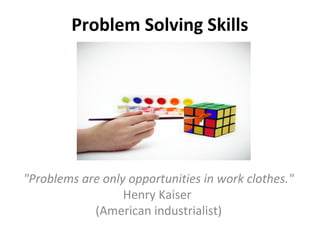
Problem Solving Skills
- 1. Problem Solving Skills "Problems are only opportunities in work clothes." Henry Kaiser (American industrialist)
- 3. The Simplex Model This quiz is based on Min Basadur's Simplex problem-solving model. This eight-step process follows the circular pattern shown to the right, within which current problems are solved and new problems are identified on an ongoing basis.
- 4. Step1: Problem Finding • What would our customers want us to improve? What are they complaining about? • What could they be doing better if we could help them? • Who else could we help by using our core competences? • What small problems do we have which could grow into bigger ones? And where could failures arise in our business process? • What slows our work or makes it more difficult? What do we often fail to achieve? Where do we have bottlenecks? • How can we improve quality? • What are our competitors doing that we could do? • What is frustrating and irritating to our team?
- 5. Step 2: Fact Finding • Understand fully how different people perceive the situation. • Analyze data to see if the problem really exists. • Explore the best ideas that your competitors have had. • Understand customers' needs in more detail. • Know what has already been tried. • Understand fully any processes, components, services, or technologies that you may want to use. • Ensure that the benefits of solving the problem will be worth the effort that you'll put into solving it.
- 6. Step 3: Problem Definition • By the time you reach this stage, you should know roughly what the problem is, and you should have a good understanding of the facts relating to it. • From here you need to identify the exact problem or problems that you want to solve. • It's important to solve a problem at the right level. If you ask questions that are too broad, then you'll never have enough resources to answer them effectively. • Min Basadur, who created the Simplex process, suggests saying "Why?" to broaden a question, and "What's stopping you?" to narrow a question. • For example, if your problem is one of trees dying, ask "Why do I want to keep trees healthy?" This might broaden the question to "How can I maintain the quality of our environment?" • A "What's stopping you?" question here could give the answer "I don't know how to control the disease that is killing the tree." • Big problems are normally made up of many smaller ones. This is the stage at which you can use a technique like Drill Down to break the problem down to its component parts. You can also use the 5 Whys Technique, Cause and Effect Analysis and Root Cause Analysis to help get to the root of a problem.
- 7. Step 4: Idea Finding • The next stage is to generate as many problem- solving ideas as possible. • Ways of doing this range from asking other people for their opinions, through programmed creativity tools and lateral thinking techniques, to Brainstorming. You should also try to look at the problem from other perspectives. A technique like The Reframing Matrix can help with this. • Don't evaluate or criticize ideas during this stage. Instead, just concentrate on generating ideas. Remember, impractical ideas can often trigger good ones! You can also use the Random Input technique to help you think of some new ideas.
- 8. Step 5: Selection & Evaluation Techniques to help you to do this include: • Risk Analysis, which helps you explore where things could go wrong. • Impact Analysis, which gives you a framework for exploring the full consequences of your decision. • Force Field Analysis, which helps you explore the pressures for and against change. • Six Thinking Hats, which helps you explore your decision using a range of valid decision-making styles. • Use of NPVs and IRRs, which help you ensure that your project is worth running from a financial perspective.
- 9. Step 6: Planning • Action Plans help you manage simple projects – these lay out the who, what, when, where, why and how of delivering the work. • For larger projects, it's worth using formal project management techniques. By using these, you'll be able to deliver your implementation project efficiently, successfully, and within a sensible time frame. • Where your implementation has an impact on several people or groups of people, it's also worth thinking about change management. Having an appreciation of this will help you assure that people support your project, rather than opposing it or cancelling it.
- 10. Step 7: Sell Idea • Up to this stage you may have done all this work on your own or with a small team. Now you'll have to sell the idea to the people who must support it. These may include your boss, investors, or other stakeholders involved with the project. • In selling the project you'll have to address not only its practicalities, but also things such internal politics, hidden fear of change, and so on.
- 11. Step 8: Action • This is where all the careful work and planning pays off. Again, if you're implementing a large- scale change or project, you might want to brush up on your change management skills to help ensure that the process is implemented smoothly. • Once the action is firmly under way, return to stage 1, Problem Finding, to continue improving your idea. You can also use the principles of Kaizen to work on continuous improvement.
